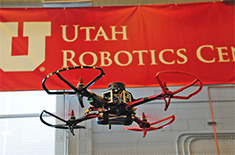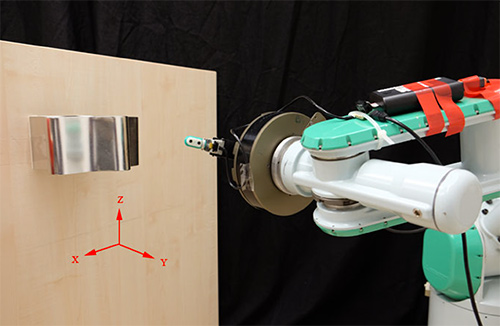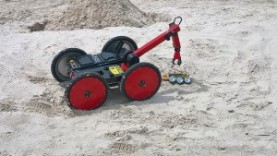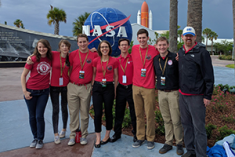Project title: Quantifying the Benefits of Head-mounting in Telemanipulated Robotic Eye Therapies Many of the up-and-coming therapeutic protocols in ophthalmology are technically difficult, near or beyond the limits of human ability, and are being attempted by only a few surgeons. Surgeon hand tremor combined with patient movement due to breathing and snoring place a lower limit on achievable precision. Over the past few years, with the support of Intuitive Surgical, Abbott and his collaborators have developed a robotic manipulator that is more precise than all prior systems designed for robot-assisted eye surgery, and which is small and light enough...
Read MoreAccepted 2017 ICRA papers by Utah Robotics Faculty and Students
The following papers by Utah Robotics faculty and students were recently accepted to the 2017 ICRA: P. Sabetian and J. Hollerbach, “A 3 Wire Body Weight Support System for a Large Treadmill”, IEEE Int. Conf. Robotics and Automation, 2017, to appear. J. J. Abbott, J. B. Brink, and B. Osting, “Computing Minimum-power Dipole Solutions for Interdipole Forces using Nonlinear Constrained Optimization with Application to Electromagnetic Formation Flight, IEEE Robotics and Automation Letters, accepted. K. M. Popek, T. Hermans, and J. J. Abbott, “First Demonstration of Simultaneous Localization and Propulsion of a Magnetic Capsule in a Lumen using a Single Rotating...
Read MoreProf. Mark Minor receives new $1.75M NSF grant for smart helmets
Project title: Reducing Traumatic Brain Injury Risk with Smart Collision Detection and Mitigation The goal of the project is to reduce the risk of Traumatic Brain Injury (TBI) through smart technology that collects sensory data to predict and characterize impacts in real-time, optimizes protective mechanisms based on impact characteristics (e.g., direction, velocity), and transmits final impact attributes to a database for further analysis and injury risk prediction. This technology will substantially improve TBI prevention and diagnosis in motor vehicle crashes, sports, and industrial accidents. The unique technology will leverage musculoskeletal and biomechanical computational models linking head linear and angular...
Read MoreOpen position in Design and Manufacturing (including robotics and automation systems)
Mechanical Engineering – Tenure-Track Faculty Position in Design and Manufacturing (including robotic and automation systems) Candidates with research interests and expertise in design and/or manufacturing are encouraged to apply. Areas of interest include, but are not limited to: additive/advanced/novel/sustainable manufacturing methods and processes, engineered materials, compliant/soft systems, micro/nanosystems, robotic and automation systems, and medical devices. Candidates must have an established record of published research, must exhibit strong potential for extramural funding within their area of expertise, and are expected to develop a vigorous research program. Candidates must also be qualified to teach courses in the core (under)graduate curriculum of a mechanical engineering...
Read MoreJake Abbott’s group publishes in IEEE Transactions on Human-Machine Systems and IEEE Robotics and Automation Letters
Jake Abbott’s group publishes two new research papers, one on how humans interact with robots designed for precision tasks such as microsurgery and another on localizing magnetic capsule endoscopes inside the human body. In their new paper “Human Velocity Control of Admittance-Type Robotic Devices With Scaled Visual Feedback of Device Motion,” published in the IEEE Transactions on Human-Machine Systems, Dr. Abbott’s group describes the control of a class of robots uses for very precise tasks. These robots are heavily geared, so that they only move in a very controlled way, and the human operator interacts directly with a force sensor...
Read MorePostdoctoral Position Available in Aerial Robotics Based Chemical Source Detection and Localization
A postdoctoral position is available in aerial robotics based chemical source detection and localization at the DARC Lab, University of Utah Robotics Center. Applicants should have a PhD in engineering (e.g., mechanical engineering, electrical engineering, etc.) or computer science, with a strong background in robotics and autonomous systems, specifically motion planning (including experience with collision avoidance), artificial intelligence (e.g., MDPs, POMDPs, etc.), and control systems. The candidate should have a desire to take on leadership responsibilities and work with graduate students, and he/she is expected to interface with an industry partner. Preference will be given to applicants with following additional skills: extensive programming skills (C/C++/Python/Matlab); experience with ROS and...
Read MoreProf. Tucker Herman’s and colleagues’ IROS 2016 paper accepted
Prof. Tucker Hermans paper entitled, “Active Tactile Object Exploration with Gaussian Processes”, was recently accepted to the 2016 IEEE/RSJ International Conference on Intelligent Robots and Systems (IROS). His co-authors are Zhengkun Yi, Roberto Calandra, Filipe Veiga, Herke van Hoof, Yilei Zhang, and Jan Peters. ABSTRACTAccurate object shape knowledge provides important information for performing stable grasping and dexterous manipulation. When modeling an object using tactile sensors, touching the object surface at a fixed grid of points can be prohibitively time consuming. In this paper, we present an active touch strategy to efficiently reduce the surface geometry uncertainty by leveraging a probabilistic representation of object surface. In particular,...
Read MoreLeang, Pardyjak, & Nevada NanoTech Receive US Army DOD Grant to Develop Chemical Sensing Aerial Robot
Kam Leang and Eric Pardyjak partnering with company Nevada NanoTech Systems, Inc., receive US Army DOD grant to develop a chemical sensing aerial robot. The two-year $1,000,000 (Utah’s share of $330,000) project, entitled, “STTR Phase II: Autonomous Broad Spectrum Environmental Sentinels“, will focus on developing an autonomous, hover-capable, flying robot with integrated real-time chemical sensing, inter-unit communication and basics swarming capabilities, and the potential for self-powering. The final platform will detect and identify airborne chemicals using an onboard Molecular Property Spectrometer (MPS)—a low-cost, MEMS-based, lab-on-a-chip platform developed with support from DARPA and the DOD. This chip provides multi-mode chemical analysis with...
Read MoreRoboUtes Placed Third in National Competition
Like the proverbial Phoenix rising from the ashes, the University of Utah’s RoboUtes student robotic team emerged from a crippling lab fire last year to place third in the 2016 RASC-AL Robo-Ops robotic competition in Houston, Texas. “Not having a central home for the team made it very difficult to have the team meet and be cohesive,” said the team’s advisor, U mechanical engineering associate professor Mark Minor. “But the core of the team really made this happen. I’m really proud of what they did.” This year’s five-person team, made up of students from the U’s mechanical engineering and...
Read MoreU Robot Team Wins Award
The University of Utah’s mining robot team struck gold in them Martian hills, winning the Innovation Award as well as third place overall in the 2016 NASA Robotic Mining Competition in Cape Canaveral, Florida. It is only the second time the team has competed in the annual contest. The Utah Mining Robotic Mining Project — comprised of 14 members from the U’s departments of mechanical engineering, electrical and computer engineering, geology, mining engineering and computer engineering — competed May 18 to 20 with a robot that simulates scooping up Martian ice. In all, 45 schools from across the country...
Read More





